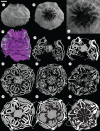Embryos, polyps and medusae of the Early Cambrian scyphozoan Olivooides
- PMID: 23446532
- PMCID: PMC3619488
- DOI: 10.1098/rspb.2013.0071
Embryos, polyps and medusae of the Early Cambrian scyphozoan Olivooides
Abstract
The Early Cambrian organism Olivooides is known from both embryonic and post-embryonic stages and, consequently, it has the potential to yield vital insights into developmental evolution at the time that animal body plans were established. However, this potential can only be realized if the phylogenetic relationships of Olivooides can be constrained. The affinities of Olivooides have proved controversial because of the lack of knowledge of the internal anatomy and the limited range of developmental stages known. Here, we describe rare embryonic specimens in which internal anatomical features are preserved. We also present a fuller sequence of fossilized developmental stages of Olivooides, including associated specimens that we interpret as budding ephyrae (juvenile medusae), all of which display a clear pentaradial symmetry. Within the framework of a cnidarian interpretation, the new data serve to pinpoint the phylogenetic position of Olivooides to the scyphozoan stem group. Hypotheses about scalidophoran or echinoderm affinities of Olivooides can be rejected.
Figures




Similar articles
-
Early Cambrian pentamerous cubozoan embryos from South China.PLoS One. 2013 Aug 12;8(8):e70741. doi: 10.1371/journal.pone.0070741. eCollection 2013. PLoS One. 2013. PMID: 23950993 Free PMC article.
-
The early Cambrian fossil embryo Pseudooides is a direct-developing cnidarian, not an early ecdysozoan.Proc Biol Sci. 2017 Dec 20;284(1869):20172188. doi: 10.1098/rspb.2017.2188. Proc Biol Sci. 2017. PMID: 29237861 Free PMC article.
-
Medusozoan phylogeny and character evolution clarified by new large and small subunit rDNA data and an assessment of the utility of phylogenetic mixture models.Syst Biol. 2006 Feb;55(1):97-115. doi: 10.1080/10635150500433615. Syst Biol. 2006. PMID: 16507527
-
Evolution and development of scyphozoan jellyfish.Biol Rev Camb Philos Soc. 2018 May;93(2):1228-1250. doi: 10.1111/brv.12393. Epub 2018 Feb 14. Biol Rev Camb Philos Soc. 2018. PMID: 29446223 Review.
-
[Environmental factors inducing the transformation of polyp into medusae in Aurelia aurita (Scyphozoa)].Ontogenez. 2017 Mar-Apr;48(2):122-33. Ontogenez. 2017. PMID: 30277361 Review. Russian.
Cited by
-
Exceptional soft tissue preservation reveals a cnidarian affinity for a Cambrian phosphatic tubicolous enigma.Proc Biol Sci. 2022 Nov 9;289(1986):20221623. doi: 10.1098/rspb.2022.1623. Epub 2022 Nov 2. Proc Biol Sci. 2022. PMID: 36321492 Free PMC article.
-
Meiofaunal deuterostomes from the basal Cambrian of Shaanxi (China).Nature. 2017 Feb 9;542(7640):228-231. doi: 10.1038/nature21072. Epub 2017 Jan 30. Nature. 2017. PMID: 28135722
-
A diploblastic radiate animal at the dawn of cambrian diversification with a simple body plan: distinct from Cnidaria?PLoS One. 2013 Jun 20;8(6):e65890. doi: 10.1371/journal.pone.0065890. Print 2013. PLoS One. 2013. PMID: 23840375 Free PMC article.
-
Early Cambrian pentamerous cubozoan embryos from South China.PLoS One. 2013 Aug 12;8(8):e70741. doi: 10.1371/journal.pone.0070741. eCollection 2013. PLoS One. 2013. PMID: 23950993 Free PMC article.
-
Life cycle evolution: was the eumetazoan ancestor a holopelagic, planktotrophic gastraea?BMC Evol Biol. 2013 Aug 16;13:171. doi: 10.1186/1471-2148-13-171. BMC Evol Biol. 2013. PMID: 23957497 Free PMC article. Review.
References
-
- Bengtson S, Yue Z. 1997. Fossilized metazoan embryos from the earliest Cambrian. Science 277, 1645–164810.1126/science.277.5332.1645 (doi:10.1126/science.277.5332.1645) - DOI - DOI
-
- Xiao S, Zhang Y, Knoll AH. 1998. Three-dimensional preservation of algae and animal embryos in a Neoproterozoic phosphate. Nature 391, 553–55810.1038/35318 (doi:10.1038/35318) - DOI - DOI
-
- Dong X-P, Donoghue PCJ, Cheng H, Liu J. 2004. Fossil embryos from the Middle and Late Cambrian period of Hunan, south China. Nature 427, 237–24010.1038/nature02215 (doi:10.1038/nature02215) - DOI - DOI - PubMed
-
- Donoghue PCJ, Dong X-P. 2005. Embryos and ancestors. In Evolving form and function: fossils and development (ed. Briggs DEG.), pp. 81–99 New Haven, CT: Yale Peabody Museum of Natural History, Yale University
-
- Yue Z, Bengtson S. 1999. Embryonic and post-embryonic development of the Early Cambrian cnidarian Olivooides. Lethaia 32, 181–19510.1111/j.1502-3931.1999.tb00538.x (doi:10.1111/j.1502-3931.1999.tb00538.x) - DOI - DOI
Publication types
MeSH terms
LinkOut - more resources
Full Text Sources
Other Literature Sources
Miscellaneous

